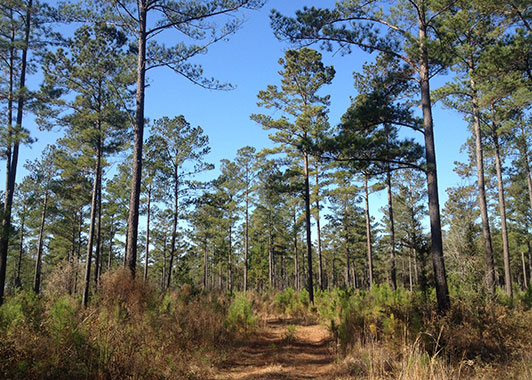By Dorinda Dallmeyer
If asked what conservation philanthropy looks like, a common response would be monetary contributions or volunteer hours. But the U.S. Army at Ft. Stewart and the Georgia-Alabama Land Trust have another way to protect important habitat along the Ogeechee River — conservation easements with private landowners.
Coastal Georgia is one of the fastest growing regions in the state. Rising property values and rising ad valorem taxes often encourage landowners to sell or to convert timberland and agricultural land into residential or commercial property. Ft. Stewart is a major economic force in the Richmond Hill/Hinesville area and intends to remain a good neighbor. Its military forces need the flexibility to train when and where they want within the confines of Ft. Stewart. Additionally, all of the longleaf pine acreage within the base must be managed with prescribed burns on a three-year rotation. Encroaching development could mean that buffers to shield residents from noise, smoke, and other forms of disturbance have to lie inside Ft. Stewart’s boundary, effectively reducing the total area and time available for training. As a result, siting of schools and high-density residential and commercial development immediately adjacent to the base is potentially incompatible with Ft. Stewart’s training and military readiness mission.
To provide incentives for adjoining property owners to keep their land in its relatively undeveloped state, the Army created the Army Compatible Use Buffer (ACUB) program. This program identifies priority areas for preservation around the base perimeter. In partnership with the Army at Ft. Stewart, the Georgia-Alabama Land Trust (GALT) works with owners to encourage them to place land under conservation easements.
According to program director Hal Robinson “Development is forever, so protection needs to be forever, too. Conservation easements are a flexible, tailored way to protect land in perpetuity. A required annual inspection by the easement holder (in this case GALT) ensures that the terms of the agreement are implemented faithfully. Because each property is unique, we work closely with private citizens and timber companies as well as public landowners like county governments to identify the conservation attributes of each parcel under consideration.”
Complementing Ft. Stewart’s protection of fourteen miles of the Ogeechee’s south bank are conservation easements protecting four miles of river frontage on its north bank. One two-mile stretch was a private donation while the other was an easement entered into by Chatham County for its Blue Sky Preserve. Hal Robinson notes “In addition to conserving habitat, these riverside easements preserve the vista for boaters to enjoy on this stretch of the Ogeechee.”
“From a landowner’s perspective, conservation easements provide a unique mechanism for individuals to protect the land they love. While we identify high-value habitat like floodplains and bottomland hardwoods that should be protected, we also recognize that a landowner may wish to continue to use the uplands as they have in the past,” said Robinson. “Conservation easements permit a limited number of home sites on the parcel as well as forestry and/or agriculture consistent with best management practices. That way, property can continue to pay for itself. ”
Historically, conserving land required a private landowner to relinquish certain valuable property rights while society benefited at little or no cost. After all, a tax deduction benefits only those landowners who have taxable income. ACUB adds an alternative incentive. Rather than donating an easement to gain a tax deduction, a landowner can choose to sell development rights (i.e., a conservation easement) to GALT, thereby contributing to a compatible use buffer. Once an appraisal is obtained and the parties agree on the price to be paid, the landowner receives a lump-sum payment and GALT holds the easement in perpetuity. Combining the donated and sold easements, GALT protects approximately 37,000 acres through the ACUB program with a donated component value of $7,000,000 over just the last five years.
Both Ft. Stewart and Ft. Benning partner with the Georgia-Alabama Land Trust in implementing the ACUB program. If you own land near Ft. Stewart and would like to help preserve military readiness and protect valuable conservation values while continuing to conserve the pristine natural beauty of your land, please contact Hal Robinson at hrobinson@galandtrust.org or (912) 508-1855; also see www.georgiaalabamalandtrust.org.

